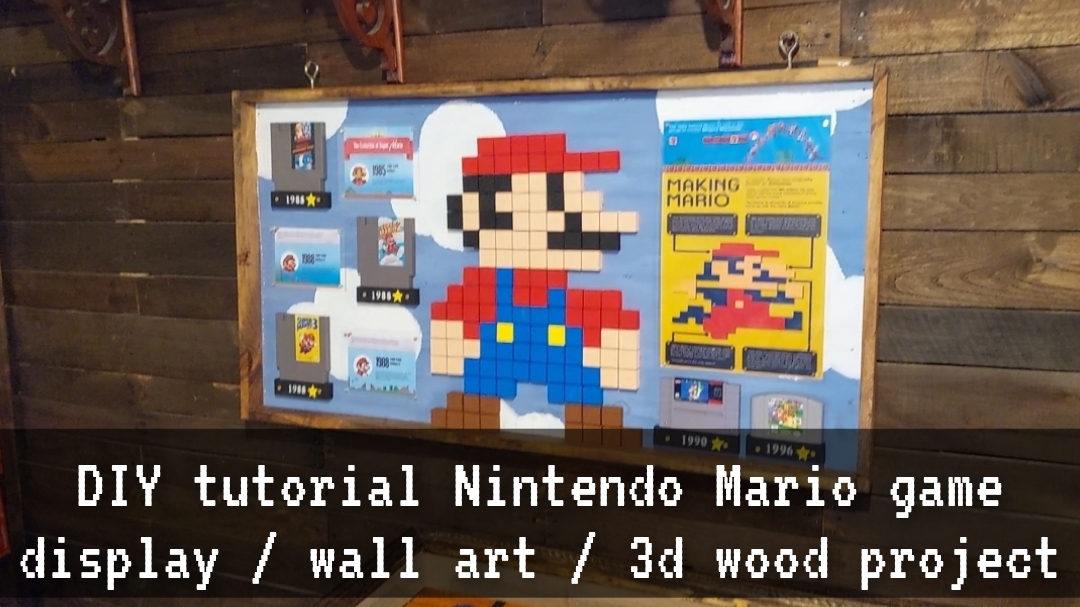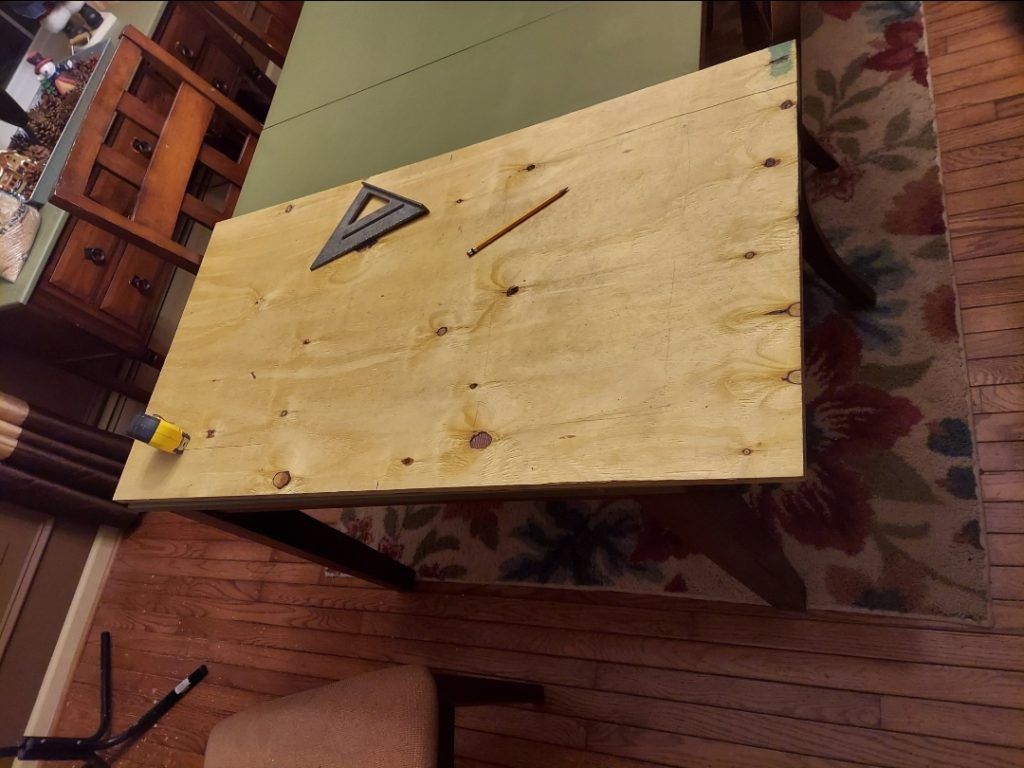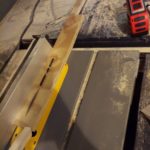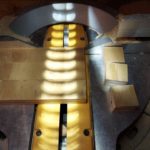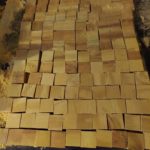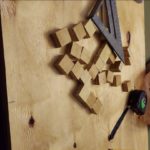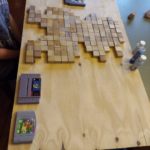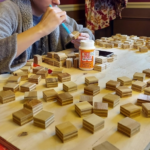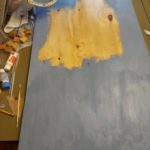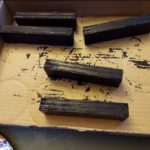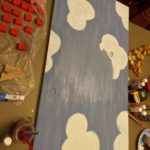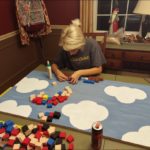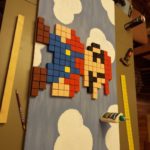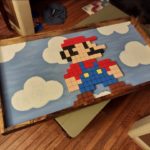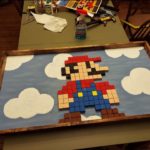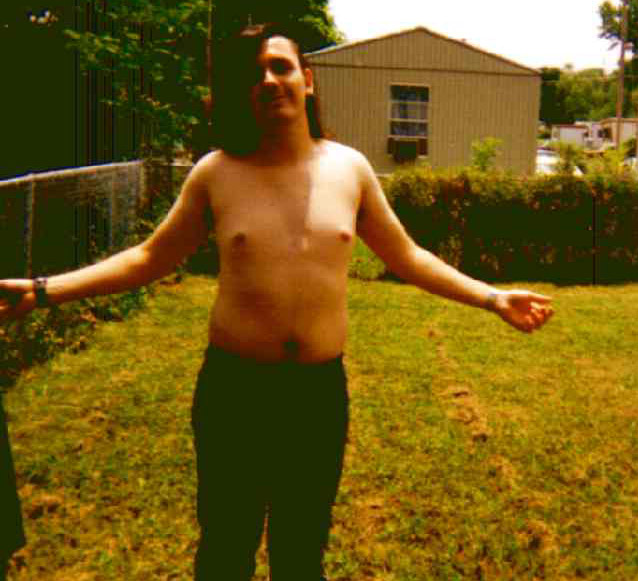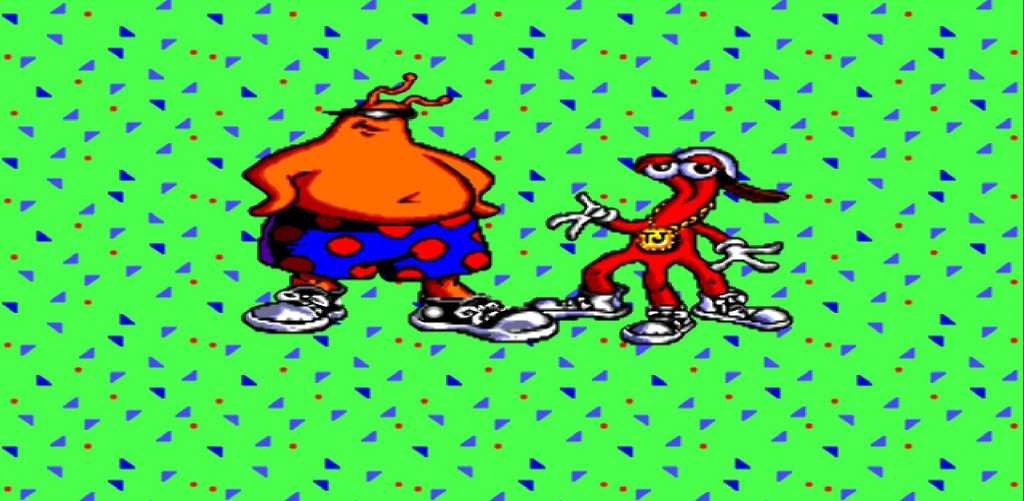For starters there is a video in relation to this project here. If you need to read everything as I do, that information is right here, below the mentioned video.
(HEY YOU!! We hope you enjoy! We try not to run ads. So basically, this is a very expensive hobby running this site. Please consider joining us for updates, forums, and more. Network w/ us to make some cash or friends while retro gaming, and you can win some free retro games for posting. Okay, carry on 👍)
Hello.
A while back I got bored and decided to make something for my man cave. I had all these extra video game carts laying around (because I collect them) and wanted to display them somehow. I also had a lot of scrap wood that I didn’t want to throw away. So I started brainstorming and put something together in like 4 hours total. A display setup for my games!
I never thought to make a DIY tutorial, but thankfully I took a bunch of pictures along the way, because I can use them to share inside this guide. I actually got the idea from watching my kids make perler bead projects. As my son was putting together a Mario Perler bead project, I saw that he was basically arranging those old 8 bit pixels. And then I thought why can’t I do something like this with wood? And then I was brainstorming for a whole 5 minutes before I was cutting out the little shapes. Anyway, lets get started shall we?
The total time if you leave out the dry time on the things I had to paint or stain, and I probably have 4 hours total into this project tops. So that’s good right? I think even a beginner can recreate this and hopefully after watching these steps you might be encouraged to do the same.
Supplies
Materials needed:
1. 46 x 24” piece of plywood. (what ever thickness you want)
2. Another piece of scrap plywood of any size or dimension as long as its at least 18 square foot in total. (to cut out your blocks.)
3. Paint or spray paint of colors of your choosing. Mario is composed of the colors red, tan, black, blue, brown and gold. The model paint is pretty cheap and so is spray paint to be honest.
4. A total of four 1” x 3” pine strips. (Two 26” in length. Two 46” in length.)
5. The video game cartridges you wish to display
6. Optional: 1 sheet of 1” thick plexiglass 2’ x 4’. You can score this yourself when the time comes or have Lowes cut it.
7. Optional: 1 string of battery powered bottle lights. (Can be obtained at any craft store)
8. Photo paper and a printer
9. Two 2” screw Eye hooks
10. Wood screws or finish nails and wood glue. Tools needed: A power drill with bits. A table saw and or chop saw. Overall project time: 4 hours
After you have your material gathered you are ready to get going. The plexiglass was a pain for be as I failed scoring it thoroughly, and broke several pieces off wrong, wasting probably ten dollars in plexiglass. Embarrassed and humbled as I hate asking for help, I kindly asked the glass cutter at Lowes to cut mine to size for me which he did. If I had to do it again I would just remember to score a few extra times before attempting to snap the plexi in half. Too easy.
Step 1: Backing board
The first thing we are going to figure out is the size of our backing board. I had ¾” plywood laying around which is total overkill I might add. You can use ½ inch or even something else like MDF. I do not think I would recommend going any thinner than that only because you want it durable right?
It may be tough to place nail your finished pine framing to the plywood if it is too thin. Anyway my scrap plywood just ended up being 46” x 24” so I decided to keep it that size and run everything off of it.
Step 2: Understanding Mario
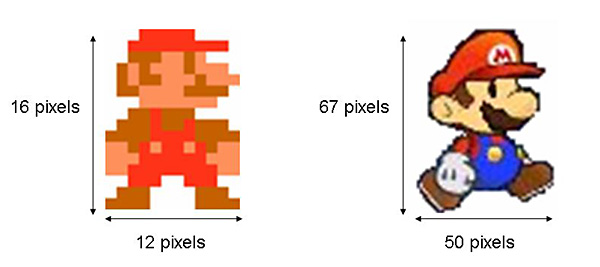
The next step was creating Mario himself. So I started googling how many pixels the original Mario was and I got something like no more than 12 pixels tall and 16 pixels wide.
Well if my son can do this with Perler beads why cant we do this with little blocks of wood. Of course we can. So as a guide I found some pixelated examples of Mario to base him off of. As you can see in this image, the pixels are broken down so you can better understand them.
As you can see the widest space is 12 pixels where as the tallest is 16. Too easy right? So we need 141 pieces of material to create our 141 pixels. You can use anything you would like, as long as they are all identical in shape and size. In this case I used more scrap plywood. Our wooden pixels are 1 ¼” x 1 ¼” and of course in my case they are the thickness of my ¾” scrap plywood I have playing around.
Step 3: Creating the blocks
So our next step is to pump out some of those little blocks to recreate Mario.
So first we want to make strips out of the plywood (or what ever material you use) that are 1/14” wide. Its as easy as setting your guard on your table saw to the required length and pushing them through. Always use some sort of push stick when feeding your wood through. Keep your fingers away from the blade. If your hands are being extended by some foreign object you should never have to worry about losing a finger.
(Oh yeah, make sure to wear safety glasses as well. I get saw dust and junk in my eyes all the time because I am a moron and fail to wear them. It can really suck when a tiny chunk of wood is in your eye for a few days or more.)
ok so after pushing enough of these things through to get the overall length of all the pixels combined we can move on to the next step. If my math is right that’s 141 pieces, and if each one is 1 ¼” then we need 177” worth of material. Or almost 15 linear ft. worth. Don’t let all this jargon scare you. You just need 1 ¼” strip of plywood at a length of 15 ft. Its too easy.
Ok so now that we have enough of the required length lets move on to the width. Its as simple as chopping them with your chop saw at 1 ¼ “. I stacked up three at a time as you can see. Cut and repeat until you have the required squares. When it is all said and done you want at least 141 of these. You really want them to be the exact size and shape.
Think of this as laying title. And if even one of your blocks is slightly out of size, you have to play games to keep your lines and edges perfect as I found out later on in my project. I was using my chop saw by eye, rather than setting up some sort of guard or stop for the wood I was cutting.
My eye was not enough and some of the pieces were off a hair and it absolutely made it a little more time consuming when it came to gluing our little squares into a pattern that resembled mario. Ok so you have all your little pieces. Great.
Step 4: Painting Mario and the background
Start laying out all of your little pieces to paint. You can do a dry run if you wish, as we did. Just to see what things look like or figure out your placement. But this was a total waste of time. Just center it and move on. That should save you a half an hour of nothing.
Now you can paint all of your little blocks as well as the backboard if you wish. We painted each one by hand and to be honest as its all just solid colors, it didn’t take that long at all. I believe she sealed them first with a product called Modge podge, but this might not be needed and is optional. When it comes to painting it may seem daunting but you blow through them pretty quickly.
If I ever made another one of these, I would spray paint them all instead. This would cut down the paint time incredibly. If I recall the garage was not very warm during this winter project, so we opted out of spray paint for that reason.
We chose to paint a blue background on the backing plywood, as well as some clouds, but to be honest anything would work here, be it a solid color, texture or pattern or even a stain. I would imagine sanding the face down really nice and then painting it black would look beautiful and if I ever decide to make another one (for a Zelda project) I would do just that. You can see these steps in the pictures attached.
We used modge podge in this step to seal the wood. This is optional but makes the painting process more smooth.
Step 5: Gluing everything down
You are almost there. Now its time to get your wood glue and start gluing your pieces down.
You can use a ruler or straight edge of some sort to make sure everything stays in line and spaced properly but to be honest we laid everything down by eye and it came together just fine. Make sure to use a good wood glue for your project and do not be afraid to use more. It dries clear and you will never see the scant amounts between the spaces in your “pixels” anyway. Be careful not to nudge or disturb anything while its drying.
Step 6: Attaching the frame
Now that that is done it is time to tack on our finished pine. These pine strips can be had at lowes and they are really inexpensive even with the rising cost of lumber. Run the pine strips along your plywood and nail them down with a healthy amount of finish nails. If you want to glue and clamp first before nailing it is always recommended however I did not bother with that. I suggest one finish nail every 2 inches. It should look something like this.
I stained the pine to match the look of my man cave, but you can paint this, stain it or even leave it plain. That is up to you. At any rate it is really fun to see this thing coming along.
Step 7: Final placements
The final steps involve placing your cartridges as well as the info / graphics you intend on using. I was able to cut all of my information out of old video game magazines. You can do the same or find some on google and print them out yourself. I would imagine you would want this to describe your games in some fashion when its hanging on the wall of your video game room.
You can laminate the paper, but I think that putting plexi in front of it just makes it look so much better. After cutting the plexi to size, make sure to predrill each hole before screwing the plexi down or you will be sure to crack the plexi. Also make sure not to tighten the screw to much, or you will surely crack the plexi as I did.
I used the same plywood strips I cut my squares out of to act as shelving to hold my video game cartridges in place. I used wood screws that had pretty heads for this, as I think it helps with the overall look and presentation. The text for each game that was stencil d onto the cart shelves in white, along with the stars which really makes it pop. If I recall we had stencils laying around for both.
One of the final steps was running or weaving bottle lights throughout the corners of the plywood to give it a look and additionally some light when the rest of the room may not be well lit. It really does look cool in the dark let me tell you. I used battery powered bottle lights with a toggle switch so I don’t have to run power to this or take up other resources in my home.
Finally I pre drilled and then screwed to eye hooks into the top of the frame, as you can see inside the photo showcasing the right hand side of the project. This thing is heavy, very heavy, so when it is said and done I would make sure it is secured into studs or other types of framing. Listed below is a gallery of the project in finished form. Please feel free to reach out to me and ask any questions you may have, and I will be happy to help you when I can find the time.
If anyone is interested I also shared this project to Instructibles.
 Retro Replay Retro Replay gaming reviews, news, emulation, geek stuff and more!
Retro Replay Retro Replay gaming reviews, news, emulation, geek stuff and more!
